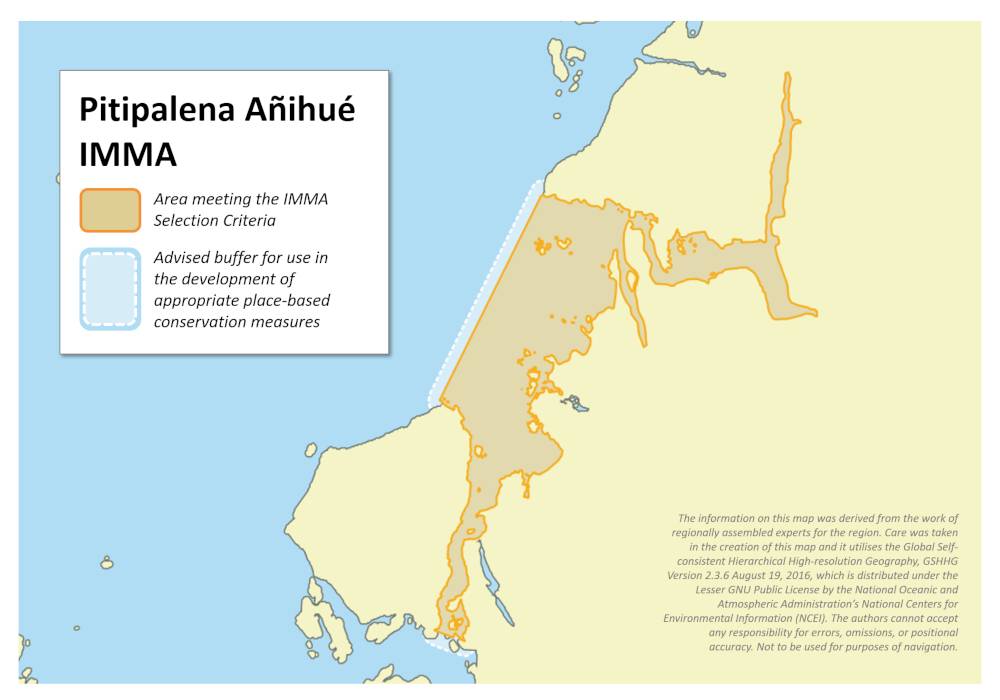Pitipalena Añihué IMMA
Size in Square Kilometres
224 km2
Qualifying Species and Criteria
Chilean dolphin – Cephalorhynchus eutropia
Criterion A; B (1)
Peale’s dolphin – Lagenorhynchus australis
Criterion B (2)
Download fact sheet
Summary
The area of the IMMA includes the sheltered and semi-enclosed Pitipalena Estuary, the entrance to the Buta Palena river, and the more exposed coast of Añihué and the Refugio Channel to the west. This area matches the multiple-use MPA Pitipalena Añihué. A small population of around 50 Chilean dolphins (Cephalorhynchus eutropia) inhabits the estuary and adjacent waterways. The sheltered shallow area inside the Pitipalena estuary seems to be particularly important for calving and nursing. Peale’s dolphins (Lagenorhynchus australis) are seen regularly within the estuary as well as along the coast to Añihué, with over 60 individuals resighted over multiple seasons. Both river and marine otters co-occur along the coast with South American sea lions and South American fur seals also regularly observed.
Description of Qualifying Criteria
Criterion A – Species or Population Vulnerability
Chilean dolphins (Cephalorhynchus eutropia ) are endemic to south-central and southern Chile and are listed as Near Threatened on the IUCN Red List (Heinrich and Reeves, 2017). Range-wide abundance is not known, but the species is thought to number in the low thousands which, if confirmed, would meet the criteria for Vulnerable status (Heinrich and Reeves, 2017). Chilean dolphins in the southern fjord region are considered genetically distinct from those along the open coast to the north of Chiloé (Pérez-Alvarez et al., 2015). The exact genetic boundary remains unclear due to a 500 km gap in sampling locations. The Pitipalena Añihué population falls within this sampling gap.
Criterion B: Distribution and Abundance
Sub-criterion B1: Small and Resident Populations
Chilean dolphins have been observed over multiple years inside the Pitipalena Estuary and adjacent coastline including the sandy shores of the Buta Palena river and the narrow embayment of Añihué (Boldt Corvalán, 2016, Heinrich and Espinosa-Miranda, 2019, Heinrich, 2021). They have also been observed entering the Buta Palena river sometimes moving at least several kilometres upstream. Dedicated cetacean surveys have been limited but reports from local people and short-term research projects support the notion that the Chilean dolphins are resident in this area. Local people report seeing Chilean dolphins inside the Pitipalena Estuary throughout the year. Year-round residency and strong site fidelity seem to be typical features of small, localised populations of Chilean dolphins elsewhere where extensive multi-year studies have been undertaken (Heinrich et al., 2019, Heinrich pers. obs.).
The local population was estimated to consist of 46 (95% C.I. 37-58) adult individuals in February 2018, with at least 4 newborns and 3 calves also present (Heinrich and Espinosa-Miranda, 2019, Heinrich, 2021). All sightings of newborns were within the protected and very shallow waters of the Pitipalena Estuary. Resighting rates of photo-identified individuals were high during a month-long survey period in 2018, indicating at least short-term site fidelity. There are only a few sightings of Chilean dolphins within the areas 100km to the north and south of the IMMA (Hucke-Gaete et al., 2022) suggesting that the IMMA constitutes important habitat for this local population at least during the summer-autumn months (when most surveys were conducted).
Sub-criterion B2: Aggregations
Peale’s dolphins Lagenorhynchus australis are also seen frequently inside the Pitipalena Estuary and along the sandy shores to Añihué and into Canal Refugio (Boldt Corvalán, 2016, Heinrich, 2021). A long-term study off Añihué identified 68 individuals, many of which were resighted across multiple seasons and years suggesting some degree of site fidelity (Sanino and Yañez, 2012). Peale’s dolphin calves are rarely seen in the area (Sanino and Yañez, 2012, Boldt Corvalán, 2016, Heinrich pers. obs during photo ID surveys, Feb 2018) indicating that the population’s range must extend beyond the currently surveyed area. Although Peale’s dolphins occur along the coastline to the north and south as well as more offshore into the Golfo Corcovado, the IMMA contains the only documented area of their continued, year-round and regular presence in this wider region.
Supporting Information
Boldt Corvalán, J. 2016. ‘Field Study of Small Cetacean Sightings from Land. The case of Raúl Marín Balmaceda. Región de Aysén’. Revista De Aysenologia 01: 33-38
Heinrich, S., 2021. First region-wide estimates of population size and status of endemic Chilean dolphins in southern Chile. IWC final report, https://iwc.int/population-endemic-chilean-dolphins-southern-chile
Heinrich, S. and Espinosa-Miranda, C. 2019. Counting needles in a complex haystack – first abundance estimates for endemic Chilean dolphins in northern Patagonia, Chile. World Marine Mammal Conference (SMM & ECS), Barcelona, Spain. December 2019. (Oral presentation).
Heinrich, S., Genov, T., Fuentes Riquelme, M. and Hammond, P. S. 2019. ‘Fine-scale habitat partitioning of Chilean and Peale’s dolphins and their overlap with aquaculture.’ Aquatic Conservation: Marine and Freshwater Ecosystems 29:212-226.
Hucke-Gaete, R., L. Bedriñana-Romano, J. Acevedo, F. Viddi, S. Buchan, W. Sielfeld, A. Aguayo-Lobo, P. Zárate, I. Cari, A. Zerbini and J. Redfern. 2022. Diseño para la estimación poblacional de cetáceos en aguas jurisdiccionales de Chile, FIPA 2021-18. Pre-Informe final. Fondo de Investigación Pesquera y de Acuicultura, Subsecretaría de Pesca y de Acuicultura. Unpublished report. 229 pp.
Sanino, G. and Meza, M.2016. ‘Ecología Trófica y Simpatría de Nutrias (Lontra felina y Lontra provocax) en la Reserva Añihué, Patagonia Chilena.’ Boletín del Museo Nacional de Historia Natural, (Boletín 65), 279-289. Disponible en https://publicaciones.mnhn.gob.cl/668/w3-article-73630.html
Sanino, G.-P., and J. L. Yañez. 2012. ‘Preliminary results of modified D-video -ID technique applied to Peale’s dolphins, Lagenorhynchus australis (Peale, 1848) at Añihué Reserve, Chile.’ Boletín del Museo Nacional de Historia Natural, Chile 61:209-227.


